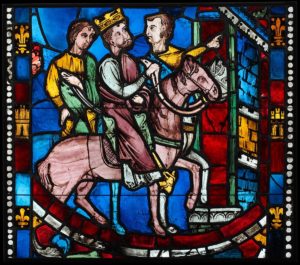
Theodosius Arrives at Ephesus, from the Seven Sleepers panels at Rouen Cathedral, now at the Cloisters, New York
A French cultural organization is trying to force several American museums to return stained glass window panels stolen from Rouen Cathedral. Philippe Machicote is president of the association Lumière sur le Patrimoine, or Spotlight on Heritage, and has actively tried to return stolen French art and artifacts to their country of origin. The organization has recently focused on items taken from France’s well-known cathedrals like Notre Dame and Rouen. Machicote alleges that the Metropolitan Museum of Art in New York, the Glencairn Museum in Pennsylvania, and the Worcester Museum in Massachusetts contain stolen stained glass from Rouen Cathedral taken from France over a century ago.
Rouen Cathedral is located in the city of the same name, the capital of Normandy, in northern France. The cathedral is particularly known for its stained glass, with the oldest and most beautiful examples dating to the early thirteenth century located along the nave’s north wall. These windows in particular are often known as Les Belles Verrieres. Nineteenth-century restorers removed many of the original stained glass window panels and stored them in the cathedral’s northwest tower. In 1911, the French art historian Jean Lafond inventoried the window panels, finding four missing. Years later, in 1932, Lafond returned and found that someone had smuggled another two out of the tower storeroom.
These missing panels are now in American museums. Most of them come from a single window telling the tale of the Seven Sleepers, a story found in both Christian and Islamic texts. According to the legend, during the third century CE, in the ancient city of Ephesus, now in modern-day Turkey, seven men faced persecution from local authorities due to them being Christian. Rather than renounce their faith, the seven escaped to a cave outside the city. The Roman authorities sealed the cave since it seemed as good as a death sentence. Nearly two hundred years later, a local farmer unsealed the cave and found the seven men still sleeping, believing it had only been a day. They awoke to find themselves in the future, with the Empire having accepted Christianity. Emperor Theodosius II traveled to Ephesus to visit them and hear their story.
Currently, five of the six missing panels are kept by American museums. The Metropolitan Museum of Art has one panel showing the emperor riding into Ephesus to hear the story of the Sleepers. It is now on display at the Cloisters, a museum dedicated to medieval art operated by the Met. The museum’s collection is housed within a French medieval monastery purchased, moved, and rebuilt by the sculptor George Grey Barnard in Manhattan’s Washington Heights neighborhood. The Worcester Museum also has a single panel showing the Sleepers relating their tale to the emperor. Three more panels are held by the Glencairn Museum, an institution for religious art established to house the collection of Raymond Pitcairn. The first of te three shows one of the sleepers going into town to buy food after his awakening, using coins from two centuries earlier. The second shows the curious townspeople bringing the sleeper to the local prefect, to whom he tells his story. The third panel is the odd one out since it is not from the Seven Sleepers story. Despite seven figures in the panel, differences in artistic style lead most art historians to conclude that a different artist made this panel and, therefore, is probably not part of the Seven Sleepers story. The figures are all kneeling together, leading some to call them the Seven Kneelers. Michael Cothren is an art history professor at Swarthmore College and now serves as consultative curator in medieval stained glass at the Glencairn Museum. According to an article he wrote on the windows, the Seven Kneelers are likely a group of apostles. In the original window, the Seven Kneelers would have been displayed next to a scene of John the Evangelist being accepted into heaven by Christ. The Seven Kneelers, according to Cothren, accompany Christ to serve as “an emblematic kneeling apostolic brotherhood”.
However, there is a sixth panel that seems to be missing. The initial four Lafond noted as missing were sold by a French dealer to the American collector Henry Lawrence. When his collection was auctioned off, Raymond Pitcairn bought three of the four panels, while the fourth went to the Worcester Museum, where it remains today. The two that Lafond later discovered missing were bought directly by Pitcairn. One is now at the Cloisters, but the other is unaccounted for. Since it was last in Pitcairn’s collection, it should be at the Glencairn Museum. However, this is unknown since the museum’s collection is not publicly viewable online, and museum officials have not yet answered our questions on this matter.
Machicote and Lumière sur le Patrimoine have filed a criminal complaint with prosecutors in Rouen regarding this matter. They have also recently brought attention to similar cases. In September 2023, the organization recognized that two pieces of stained glass sold at Sotheby’s Paris in 2015 were originally from Notre Dame. The pieces were likely taken from the cathedral in 1862 during Eugène Viollet-Le-Duc’s Notre Dame restorations. However, the prosecutor’s office in Paris refused to take any action. In the case of the Rouen window panels, authorities have approximately two months to decide to proceed with an investigation.
